engine YAMAHA JOG50R 2012 Owner's Manual
[x] Cancel search | Manufacturer: YAMAHA, Model Year: 2012, Model line: JOG50R, Model: YAMAHA JOG50R 2012Pages: 76, PDF Size: 1.51 MB
Page 45 of 76

6. Refill with the specified amount
of the recommended final trans-
mission oil, and then install and
tighten the oil filler cap. WAR-
NING! Make sure that no
foreign material enters the final
transmission case. Make sure
that no oil gets on the tire or
wheel.
[EWA11311]
7. Check the final transmission case
for oil leakage. If oil is leaking,
check for the cause.
EAUS1200
Coolant (CS50Z)
The coolant level should be checked
before each ride. In addition, the coo-
lant must be changed at the intervals
specified in the periodic maintenance
and lubrication chart.
EAUM2102
To check the coolant level
1. Place the vehicle on a level surfa-
ce and hold it in an upright posi-
tion.
TIP
●The coolant level must be chec-
ked on a cold engine since the
level varies with engine tempera-
ture.
●Make sure that the vehicle is
positioned straight up when
checking the coolant level. A
slight tilt to the side can result in
a false reading.
2. Check the coolant level through
the check window.
TIP
The coolant should be between the
minimum and maximum level marks.
1. Coolant level check window
2. Maximum level mark
3. Minimum level mark
3. If the coolant is at or below the
minimum level mark, remove the
cowling A. (See page 6-5).
4. Open the reservoir cap, and then
add coolant to the maximum
level mark. WARNING! Remove
only the coolant reservoir cap.
Never attempt to remove the
radiator cap when the engine is
hot.
[EWA15161]. NOTICE: If coolant
is not available, use distilled
MAX
MIN2
3
1
Recommended final transmission
oil:
See page 8-1
Oil quantity:
0.11 L (0.12 US qt, 0.10 Imp.qt)
Tightening torque:
Final transmission oil drain bolt:
18 Nm (1.8 m•kgf, 13.0 ft•lbf)
PERIODIC MAINTENANCE AND ADJUSTMENT
6-8
6
Page 46 of 76

water or soft tap water instead.
Do not use hard water or salt
water since it is harmful to the
engine. If water has been used
instead of coolant, replace it
with coolant as soon as possi-
ble, otherwise the cooling sys-
tem will not be protected
against frost and corrosion. If
water has been added to the
coolant, have a Yamaha dealer
check the antifreeze content of
the coolant as soon as possi-
ble, otherwise the effective-
ness of the coolant will be
reduced.
[ECA10472]
1. Coolant reservoir cap
2. Maximum level mark
3. Minimum level mark
5. Close the reservoir cap, and then
install the cowling.
EAU33031
Changing the coolant
The coolant must be changed at the
intervals specified in the periodic
maintenance and lubrication chart.
Have a Yamaha dealer change the
coolant. WARNING! Never attempt
to remove the radiator cap when
the engine is hot.
[EWA10381]EAU40370
Air filter element
The air filter element must be cleaned
and replaced at the intervals specified
in the periodic maintenance and lubri-
cation chart. Have a Yamaha dealer
clean and replace the air filter ele-
ment.
Coolant reservoir capacity:
0.25 L (0.26 US qt, 0.22 Imp.qt)
1
2
3FULL
LOW
PERIODIC MAINTENANCE AND ADJUSTMENT
6-9
6
Page 47 of 76

EAU21300
Adjusting the carburetor
The carburetor is an important part of
the engine and requires very sophisti-
cated adjustment. Therefore, all car-
buretor adjustments should be left to
a Yamaha dealer, who has the neces-
sary professional knowledge and
experience.
EAU21370
Adjusting the throttle cable
free play
1. Throttle cable free play
The throttle cable free play should
measure 2.0–5.0 mm (0.08–0.20 in) at
the throttle grip. Periodically check
the throttle cable free play and, if
necessary, adjust it as follows.
TIP
The engine idling speed must be
correctly adjusted before checking
and adjusting the throttle cable free
play.
1. Loosen the locknut.2. To increase the throttle cable free
play, turn the adjusting nut in
direction (a). To decrease the
throttle cable free play, turn the
adjusting nut in direction (b).
1. Locknut
2. Adjusting nut
3. Tighten the locknut.
1
2
a
b
1
PERIODIC MAINTENANCE AND ADJUSTMENT
6-10
6
Page 63 of 76
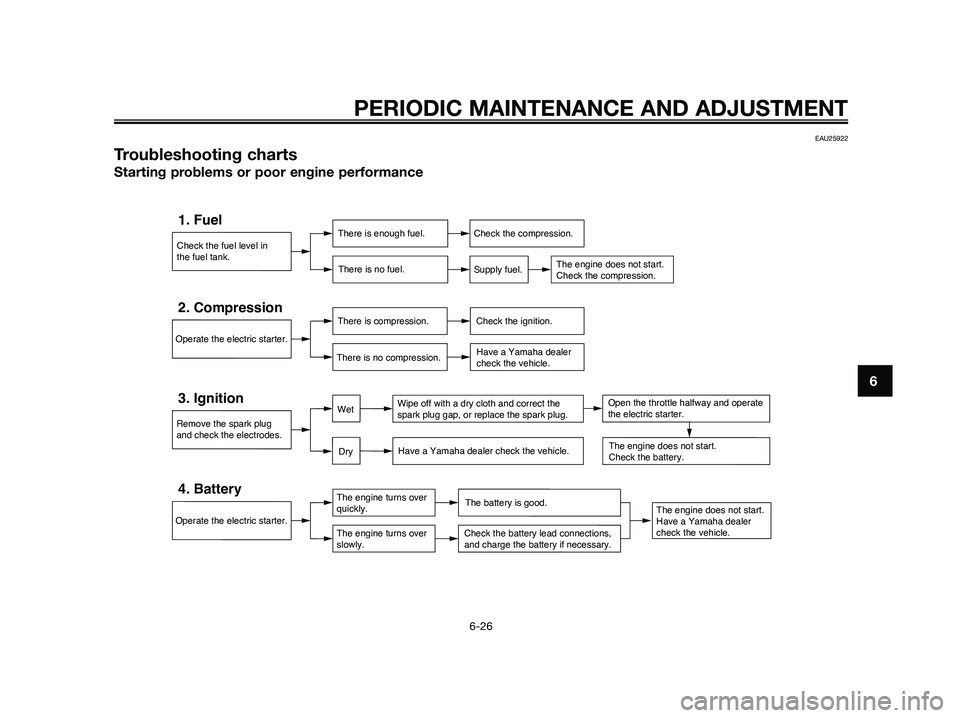
EAU25922
Troubleshooting charts
Starting problems or poor engine performance
Check the fuel level in
the fuel tank.
1. FuelThere is enough fuel.
There is no fuel.Check the compression.
Supply fuel.
The engine does not start.
Check the compression.
Operate the electric starter.
2. CompressionThere is compression.
There is no compression.Check the ignition.
Have a Yamaha dealer
check the vehicle.
Remove the spark plug
and check the electrodes.
3. IgnitionWipe off with a dry cloth and correct the
spark plug gap, or replace the spark plug.
Have a Yamaha dealer check the vehicle.
The engine does not start.
Have a Yamaha dealer
check the vehicle.
The engine does not start.
Check the battery.
Operate the electric starter.
4. BatteryThe engine turns over
quickly.
The engine turns over
slowly.The battery is good.
Check the battery lead connections,
and charge the battery if necessary.
Dry
WetOpen the throttle halfway and operate
the electric starter.
PERIODIC MAINTENANCE AND ADJUSTMENT
6-26
6
Page 64 of 76
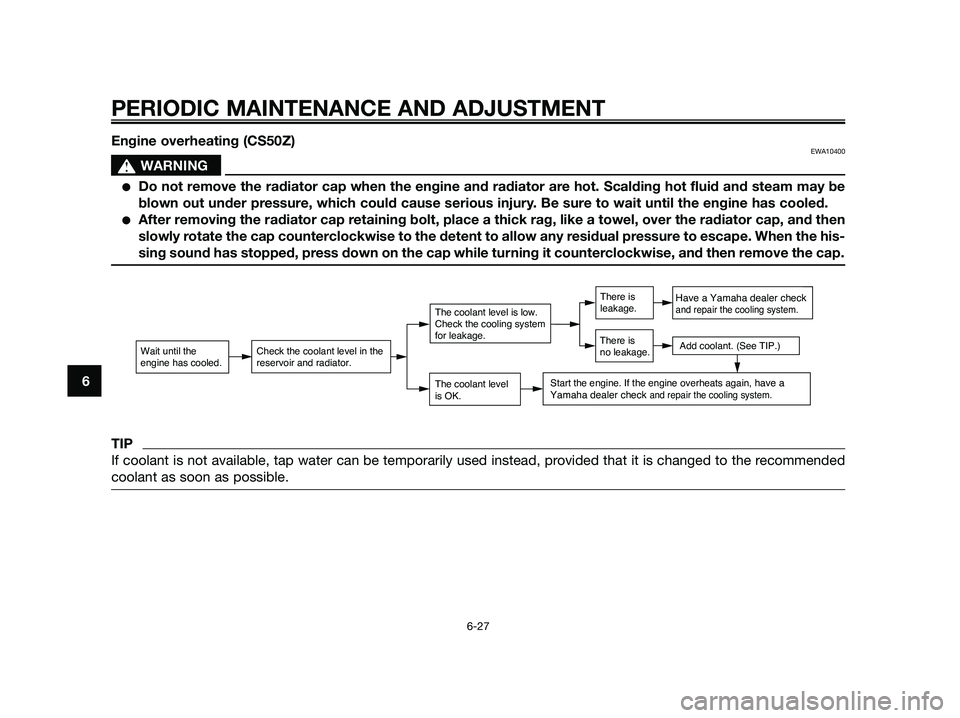
Engine overheating (CS50Z)EWA10400
sWARNING
●Do not remove the radiator cap when the engine and radiator are hot. Scalding hot fluid and steam may be
blown out under pressure, which could cause serious injury. Be sure to wait until the engine has cooled.
●After removing the radiator cap retaining bolt, place a thick rag, like a towel, over the radiator cap, and then
slowly rotate the cap counterclockwise to the detent to allow any residual pressure to escape. When the his-
sing sound has stopped, press down on the cap while turning it counterclockwise, and then remove the cap.
TIP
If coolant is not available, tap water can be temporarily used instead, provided that it is changed to the recommended
coolant as soon as possible.
Wait until the
engine has cooled.Check the coolant level in the
reservoir and radiator.
The coolant level
is OK.
The coolant level is low.
Check the cooling system
for leakage.
Have a Yamaha dealer checkand repair the cooling system.
Add coolant. (See TIP.)
Start the engine. If the engine overheats again, have a
Yamaha dealer check and repair the cooling system.
There is
leakage.
There is
no leakage.
PERIODIC MAINTENANCE AND ADJUSTMENT
6-27
6
Page 65 of 76
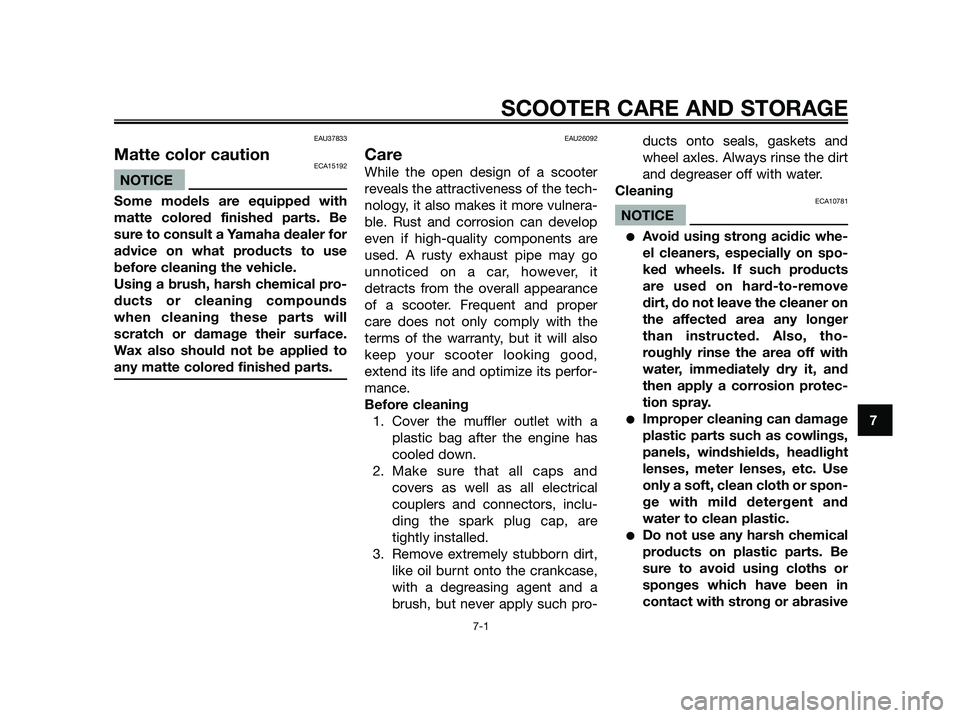
EAU37833
Matte color cautionECA15192
NOTICE
Some models are equipped with
matte colored finished parts. Be
sure to consult a Yamaha dealer for
advice on what products to use
before cleaning the vehicle.
Using a brush, harsh chemical pro-
ducts or cleaning compounds
when cleaning these parts will
scratch or damage their surface.
Wax also should not be applied to
any matte colored finished parts.
EAU26092
Care
While the open design of a scooter
reveals the attractiveness of the tech-
nology, it also makes it more vulnera-
ble. Rust and corrosion can develop
even if high-quality components are
used. A rusty exhaust pipe may go
unnoticed on a car, however, it
detracts from the overall appearance
of a scooter. Frequent and proper
care does not only comply with the
terms of the warranty, but it will also
keep your scooter looking good,
extend its life and optimize its perfor-
mance.
Before cleaning
1. Cover the muffler outlet with a
plastic bag after the engine has
cooled down.
2. Make sure that all caps and
covers as well as all electrical
couplers and connectors, inclu-
ding the spark plug cap, are
tightly installed.
3. Remove extremely stubborn dirt,
like oil burnt onto the crankcase,
with a degreasing agent and a
brush, but never apply such pro-ducts onto seals, gaskets and
wheel axles. Always rinse the dirt
and degreaser off with water.
Cleaning
ECA10781
NOTICE
●Avoid using strong acidic whe-
el cleaners, especially on spo-
ked wheels. If such products
are used on hard-to-remove
dirt, do not leave the cleaner on
the affected area any longer
than instructed. Also, tho-
roughly rinse the area off with
water, immediately dry it, and
then apply a corrosion protec-
tion spray.
●Improper cleaning can damage
plastic parts such as cowlings,
panels, windshields, headlight
lenses, meter lenses, etc. Use
only a soft, clean cloth or spon-
ge with mild detergent and
water to clean plastic.
●Do not use any harsh chemical
products on plastic parts. Be
sure to avoid using cloths or
sponges which have been in
contact with strong or abrasive
SCOOTER CARE AND STORAGE
7-1
7
Page 66 of 76
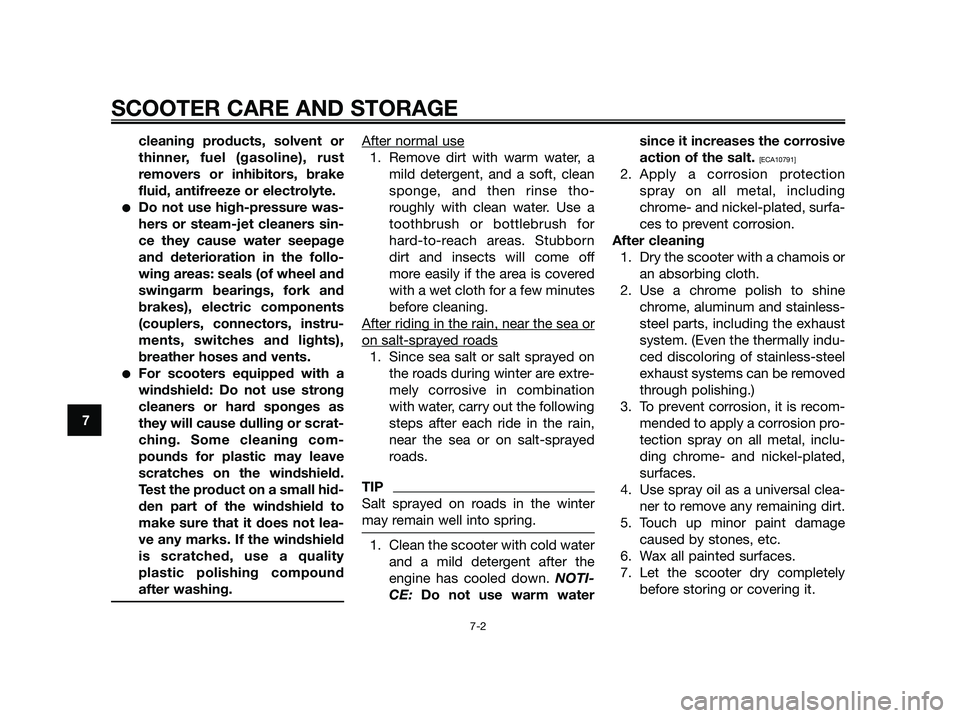
cleaning products, solvent or
thinner, fuel (gasoline), rust
removers or inhibitors, brake
fluid, antifreeze or electrolyte.
●Do not use high-pressure was-
hers or steam-jet cleaners sin-
ce they cause water seepage
and deterioration in the follo-
wing areas: seals (of wheel and
swingarm bearings, fork and
brakes), electric components
(couplers, connectors, instru-
ments, switches and lights),
breather hoses and vents.
●For scooters equipped with a
windshield: Do not use strong
cleaners or hard sponges as
they will cause dulling or scrat-
ching. Some cleaning com-
pounds for plastic may leave
scratches on the windshield.
Test the product on a small hid-
den part of the windshield to
make sure that it does not lea-
ve any marks. If the windshield
is scratched, use a quality
plastic polishing compound
after washing.
After normal use
1. Remove dirt with warm water, a
mild detergent, and a soft, clean
sponge, and then rinse tho-
roughly with clean water. Use a
toothbrush or bottlebrush for
hard-to-reach areas. Stubborn
dirt and insects will come off
more easily if the area is covered
with a wet cloth for a few minutes
before cleaning.
After riding in the rain, near the sea or
on salt-sprayed roads
1. Since sea salt or salt sprayed on
the roads during winter are extre-
mely corrosive in combination
with water, carry out the following
steps after each ride in the rain,
near the sea or on salt-sprayed
roads.
TIP
Salt sprayed on roads in the winter
may remain well into spring.
1. Clean the scooter with cold water
and a mild detergent after the
engine has cooled down. NOTI-
CE:Do not use warm watersince it increases the corrosive
action of the salt.
[ECA10791]
2. Apply a corrosion protection
spray on all metal, including
chrome- and nickel-plated, surfa-
ces to prevent corrosion.
After cleaning
1. Dry the scooter with a chamois or
an absorbing cloth.
2. Use a chrome polish to shine
chrome, aluminum and stainless-
steel parts, including the exhaust
system. (Even the thermally indu-
ced discoloring of stainless-steel
exhaust systems can be removed
through polishing.)
3. To prevent corrosion, it is recom-
mended to apply a corrosion pro-
tection spray on all metal, inclu-
ding chrome- and nickel-plated,
surfaces.
4. Use spray oil as a universal clea-
ner to remove any remaining dirt.
5. Touch up minor paint damage
caused by stones, etc.
6. Wax all painted surfaces.
7. Let the scooter dry completely
before storing or covering it.
SCOOTER CARE AND STORAGE
7-2
7
Page 68 of 76
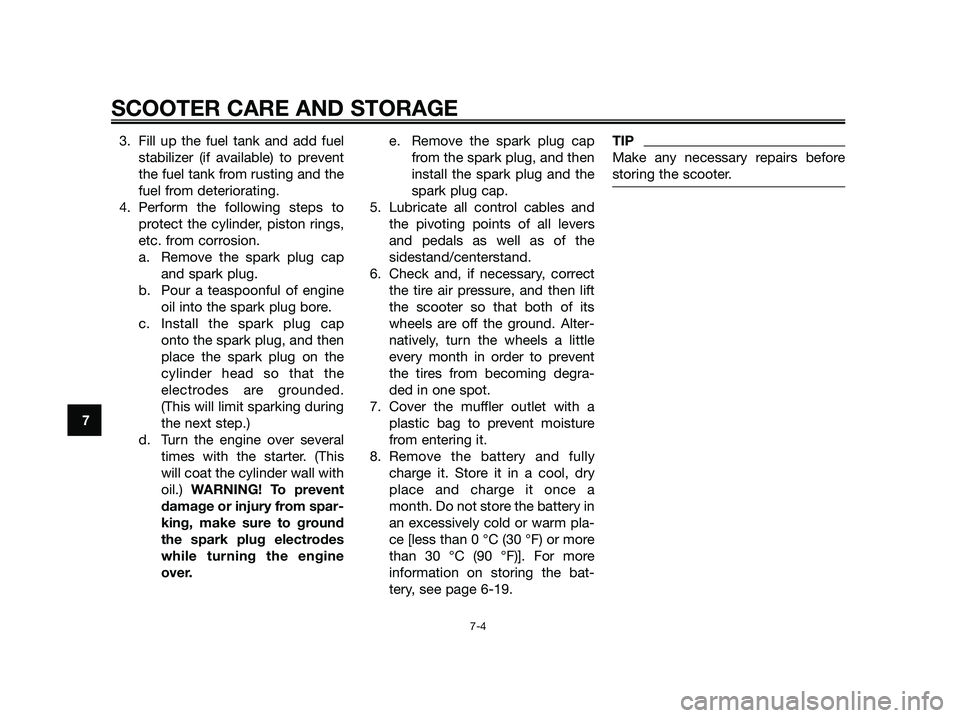
3. Fill up the fuel tank and add fuel
stabilizer (if available) to prevent
the fuel tank from rusting and the
fuel from deteriorating.
4. Perform the following steps to
protect the cylinder, piston rings,
etc. from corrosion.
a. Remove the spark plug cap
and spark plug.
b. Pour a teaspoonful of engine
oil into the spark plug bore.
c. Install the spark plug cap
onto the spark plug, and then
place the spark plug on the
cylinder head so that the
electrodes are grounded.
(This will limit sparking during
the next step.)
d. Turn the engine over several
times with the starter. (This
will coat the cylinder wall with
oil.) WARNING! To prevent
damage or injury from spar-
king, make sure to ground
the spark plug electrodes
while turning the engine
over. e. Remove the spark plug cap
from the spark plug, and then
install the spark plug and the
spark plug cap.
5. Lubricate all control cables and
the pivoting points of all levers
and pedals as well as of the
sidestand/centerstand.
6. Check and, if necessary, correct
the tire air pressure, and then lift
the scooter so that both of its
wheels are off the ground. Alter-
natively, turn the wheels a little
every month in order to prevent
the tires from becoming degra-
ded in one spot.
7. Cover the muffler outlet with a
plastic bag to prevent moisture
from entering it.
8. Remove the battery and fully
charge it. Store it in a cool, dry
place and charge it once a
month. Do not store the battery in
an excessively cold or warm pla-
ce [less than 0 °C (30 °F) or more
than 30 °C (90 °F)]. For more
information on storing the bat-
tery, see page 6-19.TIP
Make any necessary repairs before
storing the scooter.
SCOOTER CARE AND STORAGE
7-4
7
Page 69 of 76
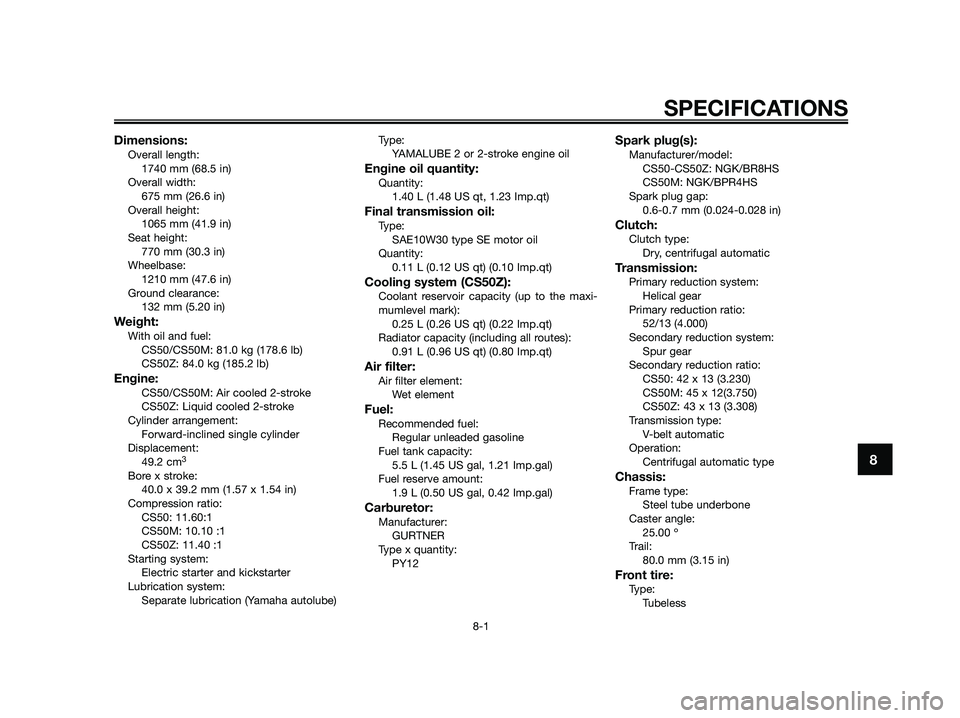
Dimensions:Overall length:
1740 mm (68.5 in)
Overall width:
675 mm (26.6 in)
Overall height:
1065 mm (41.9 in)
Seat height:
770 mm (30.3 in)
Wheelbase:
1210 mm (47.6 in)
Ground clearance:
132 mm (5.20 in)
Weight:With oil and fuel:
CS50/CS50M: 81.0 kg (178.6 lb)
CS50Z: 84.0 kg (185.2 lb)
Engine:CS50/CS50M: Air cooled 2-stroke
CS50Z: Liquid cooled 2-stroke
Cylinder arrangement:
Forward-inclined single cylinder
Displacement:
49.2 cm
3
Bore x stroke:
40.0 x 39.2 mm (1.57 x 1.54 in)
Compression ratio:
CS50: 11.60:1
CS50M: 10.10 :1
CS50Z: 11.40 :1
Starting system:
Electric starter and kickstarter
Lubrication system:
Separate lubrication (Yamaha autolube)Type:
YAMALUBE 2 or 2-stroke engine oil
Engine oil quantity:Quantity:
1.40 L (1.48 US qt, 1.23 Imp.qt)
Final transmission oil:Type:
SAE10W30 type SE motor oil
Quantity:
0.11 L (0.12 US qt) (0.10 Imp.qt)
Cooling system (CS50Z):Coolant reservoir capacity (up to the maxi-
mumlevel mark):
0.25 L (0.26 US qt) (0.22 Imp.qt)
Radiator capacity (including all routes):
0.91 L (0.96 US qt) (0.80 Imp.qt)
Air filter:Air filter element:
Wet element
Fuel:Recommended fuel:
Regular unleaded gasoline
Fuel tank capacity:
5.5 L (1.45 US gal, 1.21 Imp.gal)
Fuel reserve amount:
1.9 L (0.50 US gal, 0.42 Imp.gal)
Carburetor:Manufacturer:
GURTNER
Type x quantity:
PY12
Spark plug(s):Manufacturer/model:
CS50-CS50Z: NGK/BR8HS
CS50M: NGK/BPR4HS
Spark plug gap:
0.6-0.7 mm (0.024-0.028 in)
Clutch:Clutch type:
Dry, centrifugal automatic
Transmission:Primary reduction system:
Helical gear
Primary reduction ratio:
52/13 (4.000)
Secondary reduction system:
Spur gear
Secondary reduction ratio:
CS50: 42 x 13 (3.230)
CS50M: 45 x 12(3.750)
CS50Z: 43 x 13 (3.308)
Transmission type:
V-belt automatic
Operation:
Centrifugal automatic type
Chassis:Frame type:
Steel tube underbone
Caster angle:
25.00 º
Trail:
80.0 mm (3.15 in)
Front tire:Type:
Tubeless
SPECIFICATIONS
8-1
8
Page 74 of 76

2-stroke engine oil ...................................3-10
AAcceleration and deceleration ...................5-2
Air filter element .........................................6-9
Auxiliary light bulb, replacing ...................6-24
BBattery......................................................6-19
Brake fluid level, checking .......................6-15
Brake fluid, changing ...............................6-16
Brake lever, front ........................................3-6
Brake lever, rear .........................................3-7
Brake levers, lubricating ..........................6-16
Brake pads and shoes, checking ............6-14
Braking .......................................................5-3
CCarburetor,adjusting.................................6-10
Care............................................................7-1
Catalytic converter .....................................3-9
Centerstand, checking and lubricating ....6-17
Coolant.......................................................6-8
Cowling and panel, removing
and installing............................................6-5
DDimmer switch ...........................................3-6
EEngine break-in ..........................................5-4
FFinal transmission oil .................................6-7
Front brake lever free play, checking.......6-13
Front fork, checking .................................6-18
Fuel ............................................................3-8
Fuel and 2-stroke engine oil tank caps .....3-7
Fuel consumption, tips for reducing ..........5-3
Fuse, replacing.........................................6-20
HHandlebar switches ...................................3-6
Headlight and front turn signal light
bulb, replacing .......................................6-21
High beam indicator light...........................3-2
Horn switch ................................................3-6
IIdentification numbers ...............................9-1
Indicator and warning lights ......................3-2
KKey identification number ..........................9-1
Kickstarter ................................................3-10
LLicense plate light bulb, replacing ...........6-24
Luggage hook ..........................................3-13
M
Main switch/steering lock ..........................3-1
Matte color, caution ...................................7-1
Model label ................................................9-2
Multi-function display ................................3-4
OOil level warning light .................................3-3
PParking .......................................................5-4
Part locations .............................................1-5
Periodic maintenance and lubrication
chart .........................................................6-2
Pre-operation check list .............................4-2
RRear brake lever free play, adjusting .......6-13
Rider seat .................................................3-11
SSafe-riding points.......................................1-5
Safety information ......................................1-1Shock absorber assembly, adjusting.......3-12
Spark plug, checking .................................6-6
Specifications.............................................7-3
Speedometer .............................................3-3
Start switch ................................................3-6
Starting a cold engine ................................5-1
Starting off .................................................5-2
Steering, checking ...................................6-18
Storage.......................................................7-3
Storage compartment ..............................3-11
TTail/brake light bulb or rear turn signal
light bulb, replacing ...............................6-23
Throttle cable free play, adjusting ............6-10
Throttle grip and cable, checking and
lubricating ..............................................6-16
Tires .........................................................6-11
Troubleshooting .......................................6-25
Troubleshooting charts ............................6-26
Turn signal indicator lights .........................3-2
Turn signal switch ......................................3-6
VVehicle identification number .....................9-1
WWheel bearings, checking........................6-19
Wheels .....................................................6-12
INDEX